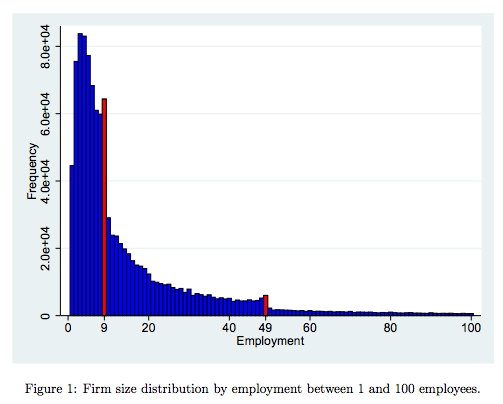Will ObamaCare Discourage Small Firms From Growing Past 50 Employees?
ObamaCare imposes a fine on employers who do not provide qualifying health insurance for their employees. This is supposed to encourage employers to offer health insurance and keep too many from dumping workers onto the law's new health insurance exchanges. But there's a significant exemption: Small businesses, defined as those with fewer than 50 employees, don't have to pay the fine.
That provides some relief for small businesses. But it also provides an obvious incentive for them to stay small by penalizing companies that pass the 49-employee threshold. Growing companies will likely think long and hard about pushing past that mark, perhaps delaying hiring or declining it altogether in order to avoid the law's fines. Many will probably choose to grow to 49 employees and then stop, at least temporarily.
We can see this effect at work in France, which regulates companies with 50 or more workers far more heavily than those with 49 or less. A December 2012 paper by Boston University economist Francois Gourio and University of Wisconsin economist Nicolas A. Roys for the National Bureau of Economic Research notes that, as a result of the regulatory cliff, the size distribution of firms in France "is visibly distorted: there are many firms with exactly 49 employees." And they've got the graphs to prove it.
Here's their graph showing the distribution of firms with between 1 and 100 employees:

And here's a zoomed-in detail of the same graph showing the number of firms with between 40 and 60 employees:

Not only do you see pretty big dropoff at the 50 employee mark, you also see an oversized cluster of firms with exactly 49 employees. This is exactly what you'd expect given that there's a penalty for growing larger.
Gourio and Roys conclude that the regulatory threshold as "a sunk cost that must be paid the first time the firm reaches 50 employees." The stark dividing line, they say, "clearly distorts the ?rm size distribution, leading to an obvious misallocation of labor," and removing it could lead to a 0.3 percent productivity improvement if the number of firms stays the same.
It's hard to predict exactly how U.S. businesses will react to ObamaCare's dividing line. But I'd be surprised if we didn't see some measurable effect, and a noticeable increase in the number of firms with exactly 49 employees coinciding with a decrease in the number who employ 50 or a little more. In other words, it's yet another way that ObamaCare discourages some employers from hiring and probably makes it harder to create new jobs.
(Hat tip to Gabriel Rossman for pointing out the study.)


Show Comments (111)